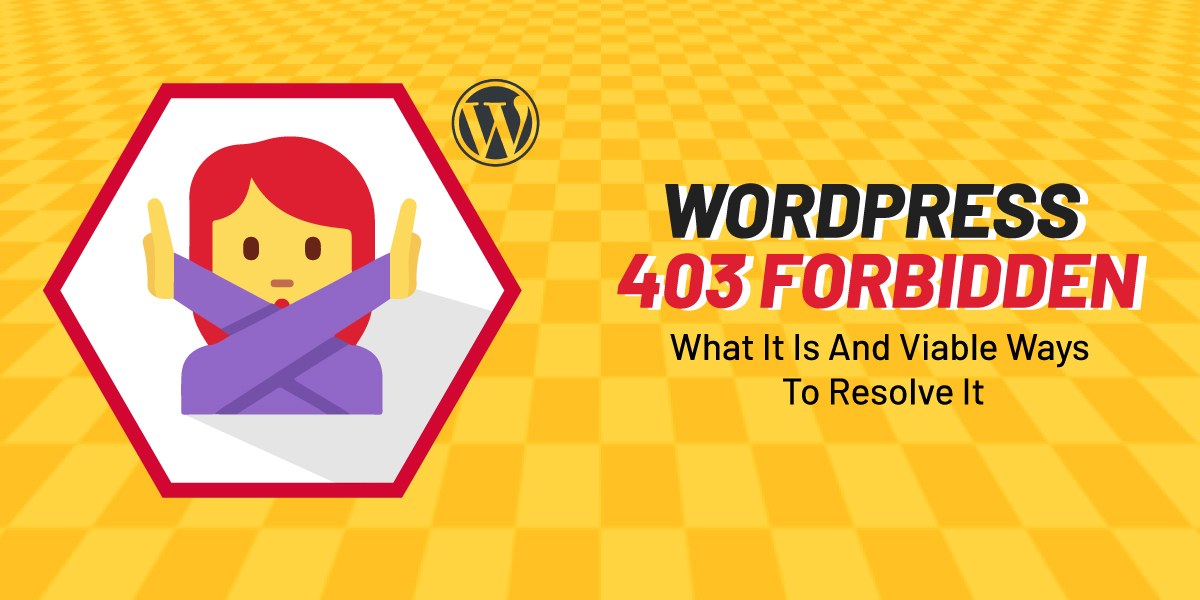
WordPress 403 Forbidden-What It Is and Viable Ways to Resolve It
Last updated on October 13th, 2021 at 10:22 am
One of the worst nightmares that any WordPress developer or owner can have is to see 403 Forbidden errors again and again. Sometimes, it can be so stubborn that you end up beating your head against the wall. Well, as long as we are here, we make sure you won’t end up doing so as we present this crisp guide on WordPress 403 for forbidden errors. So, stay tuned.
The Nitty-gritty of 403 Forbidden Error in WordPress
To begin with, 403 Forbidden error is a type of HTTP status code error that commonly occurs in WordPress. It refers to the issue when the server understands the service request but fails to authorize it. So, the server takes the help of this code to bring the error to the public’s notice.
There are a couple of variations in this code.
- 403 Forbidden
- HTTP Error 403 – Forbidden
- Forbidden: You don’t have permission to access [directory] on this server
- Forbidden
- Error 403
This variation happens due to different kinds of browsers and servers. Despite the variations, all these errors have the same meaning.
The persistence of this error prevents users to access the website which causes low Google ranking, less traffic, and reduced database. In the case of an e-commerce website, it leads to a loss of revenue as well. This is something that no website owner would like to face.
What Causes 403 Forbidden Error?
Before we talk about the ways to resolve this error, let’s discuss the key reasons behind the occurrence of this error. Majorly, this WordPress error occurs when:
There is restricted content by many means– You’ll end up facing this error when the owner of the content has kept it private for whatsoever reasons. Other than this, the error is going to bother even if the content is user and geographical restricted.
An IP address is blocked- If your IP address is blocked, due to reasons like spam and unwanted posts, you have to deal with this error.
There is hotlink protection – Sometimes, website owners include hotlink protection on their website just to prevent unauthorized access to the copyrighted material. In that case, users can face 403 forbidden errors.
- A faulty or corrupt plugin is present.
- A broken .htaccess file is there.
How To Fix Forbidden 403 WordPress Error?
Now it’s clear what the Forbidden 403 WordPress error means and what can cause this error. It’s time to understand some of the viable ways to fix this error. We discussed with a few IT experts and have come up with a list of tried & tested remedial solutions. They are so easy to implement that even a novice can easily taste success, using them. So, let’s get started.
Solution #1- Try changing the file permissions
Whatever WordPress file is present on your site’s server comes with its specific permissions. The kind of permissions these files have decides the accessibilities. In case of incorrect permissions, the server will stop others from accessing them.
So, changing the file permission can make this error go away in a blink of an eye. If you don’t know what kind of permission your files use, contact your hosting provider or hire a technical expert to figure this out. This isn’t a tough task and you can do it by yourself.
Just connect your site with a secure file transfer protocol client like FileZilla. It will make things clear. Also, you can access the site via the file manager in the hosting account.
Solution #2 – Remove or deactivate faulty plugins
As the presence of default plugins may have caused this error, removing or deactivating them can fix this issue. However, one has to figure out which plugin is causing this error. To make this work, deactivate and reactivate all of the plugins available on the website.
This can be done by connecting the website with FileZilla or any other file manager present in the hosting account. Visit the site’s root directory, open the wp-content folder, and try to find out the plugins folder.
In the list of all plugins, right-click on the plugins folder and click Rename.
Enter the new name for the folder. Doing so will automatically deactivate the plugins. Access the website once again. If things are fine now then it’s good news for you. Now, the next wise step is to figure out which plugin was causing the trouble. For this, return to the website’s root directory, rename the plugins folder back to “plugins”, navigate to the plugins pages, and try activating one plugin at a time. Keep on going till the time you spot the culprit.
Solution #3 – Clear the cookies and cache
When too much information is cluttered or so many accesses are granted, using the cookies & cache, the 403 forbidden error is going to raise its head. One simple solution, to get rid of this issue, is to delete the cookies & cache. Keep in mind that, by clearing cookies & caches, all the saved passwords will also be deleted.
Solution #5- Disable the hotlink protection
Enabling the hotlink protection is a key reason for this problem. So, if this is the case, you must learn the tactics for disabling the hotlink protection. Visit the cPanel of the website, head to the Security section, and click on ‘Hotlink Protection. Disable it and access the website. If that was the cause, a website should work fine.
Solution #6- Generate the .htaccess file
Websites that are not hosted on NGINX web server are likely to face 403 forbidden WordPress error because of a broken or corrupt .htaccess file.
Mostly, this happens when the Apache web server is used for web servers. If you’re sure that this file is causing the notorious 403 forbidden errors, deleting it can resolve the issues. But, this can be too tedious and exhaustive. So, the wise move here is to generate a new one. Here are the steps to be followed:
- Using the FTP, connect to web hosting
- Look for the .htaccess file in the root folder of the website.
- Create a backup of the file by downloading a copy of it on your device.
- Delete the present .htaccess file once the copy of the original one is created safely.
- To generate the new file, visit the WordPress dashboard and go to the Settings → Permalinks
- Click on the ‘Save Changes’ option, present at the bottom of the page. The job is done.
Solution #7 – Try deactivating the CDN of the website
The very first reason that we stated for this issue is to have restricted content. This is the case with you, mostly the website will display the 403 forbidden error when website assets like images, CSS, and JavaScript are accessed. The ideal solution is to deactivate the CDN or Content Delivery Network for a while. CDN is a network of servers, deployed in different parts of the world, and hosting a copy of the website.
Disabling the CDN is easy. All you need to do is, logging into the hosting account, spotting the CDN settings, and disabling it. If you’re having a tough time spotting the CDN setting, better to call out the hosting provider to help.
Solution #8 – Check the permission of the URL
Websites, which demand a prior login to access the content present, then 403 forbidden errors will pop up when URL access permission is not granted. Servers use this error to remind you that a login is required. So, check the status of URL permission.
Solution #9 – Contact the hosting provider
If nothing worked, which is a rarity, your last resort is the web hosting service provider. Let the experts handle this error
Ending notes
We all know that WordPress 403 forbidden error is prevalent and can occur without any prior. But, not many of us know that this error can reduce the Google ranking of the website massively and even can lead to revenue loss if ignored for a longer time. So, take it seriously.
Try to gather as much as information you can, about this silent killer and equip yourself to beat it. Gladly, this isn’t going to be a tedious job as its remedial solutions are very easy. Most of the time, you don’t have to be a tech-geek to get rid of this error. Try the above-mentioned solutions and we’re sure that you will be able to defeat the WordPress 403 forbidden error.
If not, then don’t hesitate to take experts’ help as this is something that can’t be ignored.


